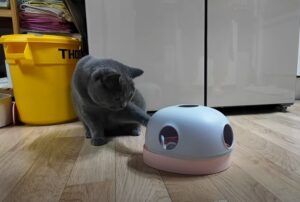DIY Puzzle Feeders for Cats: Easy Enrichment with Household Items

Discover how to make easy DIY puzzle feeders for cats using everyday household items. Keep your feline friend mentally stimulated and entertained on a budget!
🧩 What Are Puzzle Feeders and Why Do Cats Love Them?
Cats are natural hunters. In the wild, they spend a significant portion of their day stalking, chasing, and catching prey. However, our indoor feline companions often miss out on this crucial mental and physical stimulation. That’s where puzzle feeders come in.
Puzzle feeders are interactive food-dispensing toys that challenge your cat to work for their food. These feeders promote mental enrichment, help reduce boredom, and can even prevent behavioral issues like overgrooming or destructive scratching. While there are plenty of commercial puzzle feeders available, you can easily create your own using common household items—saving money while still giving your cat the stimulation they crave.
In this post, we’ll walk you through the benefits of puzzle feeders, show you how to make them at home, and share tips to keep your cat engaged and happy.
🏠 DIY Puzzle Feeders Using Household Items
Creating a puzzle feeder doesn’t require fancy tools or expensive materials. With a little creativity, you can transform everyday items into stimulating food-dispensing toys your cat will love. Here are some simple and effective DIY puzzle feeder ideas:
1. Toilet Paper Roll Puzzle
Materials Needed:
- Empty toilet paper rolls
- Scissors
- Cat kibble or small treats
Instructions:
- Flatten one end of the toilet paper roll and fold it inward to close.
- Fill the roll with a small amount of dry food or treats.
- Fold the other end closed.
- Cut small holes around the roll just big enough for the kibble to fall through.
- Let your cat bat the roll around to release the food.
Why it works:
This feeder encourages your cat to use its paws and nose to manipulate the object, mimicking natural hunting behavior.
2. Egg Carton Treat Tray
Materials Needed:
- Clean, empty egg carton (paper or plastic)
- Cat kibble or treats
Instructions:
- Open the egg carton and place small amounts of kibble in each cup.
- For added difficulty, place small balls or crumpled paper over some cups.
- Close the lid loosely or leave it open depending on your cat’s skill level.
Why it works:
This feeder allows you to vary the difficulty level and helps slow down fast eaters.
3. Muffin Tin Brain Game
Materials Needed:
- Muffin tin
- Cat treats or dry food
- Ping pong balls or small toys
Instructions:
- Drop a few pieces of dry food into each muffin cup.
- Place a ping pong ball or small toy on top of the food in each cup.
- Let your cat figure out how to move the balls to get to the food.
Why it works:
This setup promotes problem-solving and paw-eye coordination, making mealtime more engaging.
4. Plastic Bottle Spinner
Materials Needed:
- Empty plastic water bottle
- Knife or scissors
- String or wire
- Cat kibble
Instructions:
- Cut small holes in the bottle just big enough for kibble to fall through.
- Thread a string or wire through the bottle’s neck and suspend it horizontally.
- Fill the bottle with kibble and let it hang just above the ground.
- Your cat will have to bat at the bottle to release the food.
Why it works:
This feeder adds a physical challenge and encourages active play, especially for high-energy cats.
🐾 Benefits of DIY Puzzle Feeders for Cats
DIY puzzle feeders aren’t just fun—they offer a range of benefits for your cat’s well-being:
| Benefit | Description |
|---|---|
| Mental Stimulation | Keeps your cat’s brain active and engaged. |
| Physical Exercise | Encourages movement and play, reducing obesity risk. |
| Slower Eating | Helps prevent vomiting and bloating from eating too quickly. |
| Behavioral Improvement | Reduces boredom-related behaviors like scratching or aggression. |
| Bonding Time | Watching and interacting with your cat during feeding can strengthen your bond. |
🧠 Tips for Introducing Puzzle Feeders
If your cat is new to puzzle feeders, start simple. Here are some tips to ensure success:
- Start Easy: Begin with open designs like the egg carton to build confidence.
- Use High-Value Treats: Tempt your cat with their favorite snacks to spark interest.
- Supervise Initially: Watch your cat during the first few uses to ensure safety.
- Rotate Designs: Keep things fresh by rotating different puzzle feeders every few days.
- Be Patient: Some cats may take time to adjust—encourage them gently without forcing.
✅ Conclusion: Enrich Your Cat’s Life with Simple DIY Puzzle Feeders
DIY puzzle feeders are a cost-effective, fun, and enriching way to engage your cat’s natural instincts. With just a few household items, you can create a variety of stimulating toys that challenge your feline friend both mentally and physically. Whether you have a curious kitten or a laid-back senior cat, puzzle feeders can improve their quality of life and make mealtime more exciting.
So, gather those empty toilet paper rolls and muffin tins—it’s time to get creative!
👉 Ready to try your first DIY puzzle feeder? Share your creations or questions in the comments below!